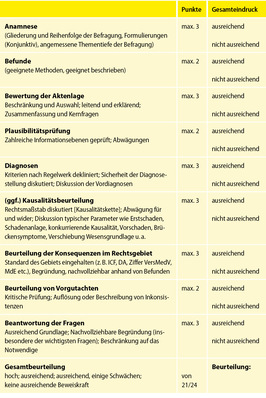Zusammenfassung
Die Berufskrankheit Koxarthrose (BK Nr. 2116) stellt für den medizinischen Sachverständigen eine neue, nicht unerhebliche Herausforderung in mehrfacher Hinsicht dar. Bislang liegt lediglich eine wissenschaftliche Begründung durch den Sachverständigenbeirat beim Bundesministerium für Arbeit und Soziales (BMAS) vor. Diese begründet zwar ausführlich die epidemiologischen Zusammenhänge zwischen Lastenhandhabung und Zustandekommen der Berufskrankheit. Die Hinweise in Bezug auf die diagnostischen Kriterien sind jedoch allenfalls vage.
Auf Initiative der Fachgesellschaft für interdisziplinäre medizinische Begutachtung (FGIMB) hat sich daher eine Arbeitsgruppe zur Erarbeitung einer Empfehlung für eine konsentierte Begutachtungsempfehlung gebildet. Am Zustandekommen der Begutachtungsempfehlung wirkten dabei sowohl Orthopäden als auch Radiologen und Arbeitsmediziner gleichermaßen mit. Nach Vorlage eines Entwurfs wurde dieser den Mitgliedern der Fachgesellschaft mit der Bitte um Stellungnahme übersandt. An der Befragung nahmen insgesamt 95 in der Begutachtung von Berufskrankheiten erfahrene Mitglieder teil.
Der medizinische Sachverständige muss zunächst klären, ob das Krankheitsbild (hier Koxarthrose) im Vollbeweis gesichert ist. Dabei galt es klare diagnostische Kriterien festzulegen. Das Krankheitsbild Koxarthrose im Sinne dieser Berufskrankheit ist charakterisiert durch das Vorliegen von Funktionsstörungen des Hüftgelenkes (einschließlich einer Notwendigkeit der Endoprothesenimplantation), als auch durch den Nachweis einer radiologischen Koxarthrose Kellgren-Lawrence Grad II oder höher.
Diese diagnostischen Kriterien wurden dabei hinlänglich im Konsens definiert und somit besteht ein anerkennungsfähiges Krankheitsbild, wenn folgende Befunde vorliegen:
- Notwendigkeit der Endoprothesenimplantation (Konsens: 74,2 %)
- subjektive Angaben auf Steifigkeit und Schmerzen sind nur bedingt brauchbar (Konsens: 98,9 %)
- die radiologische Arthroseklassifikation nach Kellgren-Lawrence ist verbindlich (Konsens: 85,1 %)
- Osteophyten und am Femurkopf > 2 mm gelten als KL II (Konsens: 89,4 %)
- Gelenkspaltweite < 2 mm gilt als KL II (Konsens: 87,4 %).
Schlüsselwörter Koxarthrose – Berufskrankheit – diagnostische Kriterien – Konsens
MedSach 119 1/2023: 11 –19
Consensus recommendation of the FGIMB on occupational disease no. 2116 (coxarthrosis).
Part I: Definition of the clinical picture
Abstract
The occupational disease coxarthrosis (BK No. 2116) represents a new, not inconsiderable challenge for the medical expert in several respects. All that is available to date is a scientific justification by the expert advisory board at the Federal Ministry of Labour and Social Affairs (BMAS). Although this explains in detail the epidemiological relationships between the handling of loads and the occurrence of the occupational disease, the information in relation to the diagnostic criteria is vague at best.
On the initiative of the Society for Interdisciplinary Medical Assessment (FGIMB), a working group has therefore been formed to develop a recommendation for a consensus assessment recommendation. Orthopaedists, radiologists and occupational physicians were equally involved in the preparation of the assessment recommendation. A draft was submitted and then sent to the members of the professional society with a request for comment. A total of 95 members experienced in the assessment of occupational diseases took part in the survey.
The medical expert must first clarify whether the clinical picture (here coxarthrosis) is fully proven. Clear diagnostic criteria had to be defined.
The clinical picture of coxarthrosis in the sense of this occupational disease is characterised by the presence of functional disorders of the hip joint (including the need for endoprosthesis implantation) as well as the detection of radiological coxarthrosis Kellgren-Lawrence grade II or higher.
These diagnostic criteria have been sufficiently defined by consensus and there is thus a recognisable clinical picture if the following findings are present:
- Need for hip replacement (consensus: 74.2%)
- Subjective information on stiffness and pain is only of limited use (consensus: 98.9%)
- The radiological classification of osteoarthritis according to Kellgren-Lawrence is binding (consensus: 85.1%)
- Osteophytes and on the femoral head >2 mm are considered KL II (consensus: 89.4%)
- Joint gap width <2 mm is considered KL II (consensus: 87.4%)
Keywords coxarthrosis – occupational disease – diagnostic criteria – consensus
Korrespondenzadresse
Prof.Dr.med. Günther Spahn
Praxisklinik für Unfallchirurgie und Orthopädie Eisenach.
Klinik für Unfall-, Hand- und Wiederherstellungschirurgie am Universitätsklinikum Jena
Sophienstr. 16
99817 Eisenach



